oil type DATSUN 610 1969 Owner's Manual
[x] Cancel search | Manufacturer: DATSUN, Model Year: 1969, Model line: 610, Model: DATSUN 610 1969Pages: 171, PDF Size: 10.63 MB
Page 134 of 171
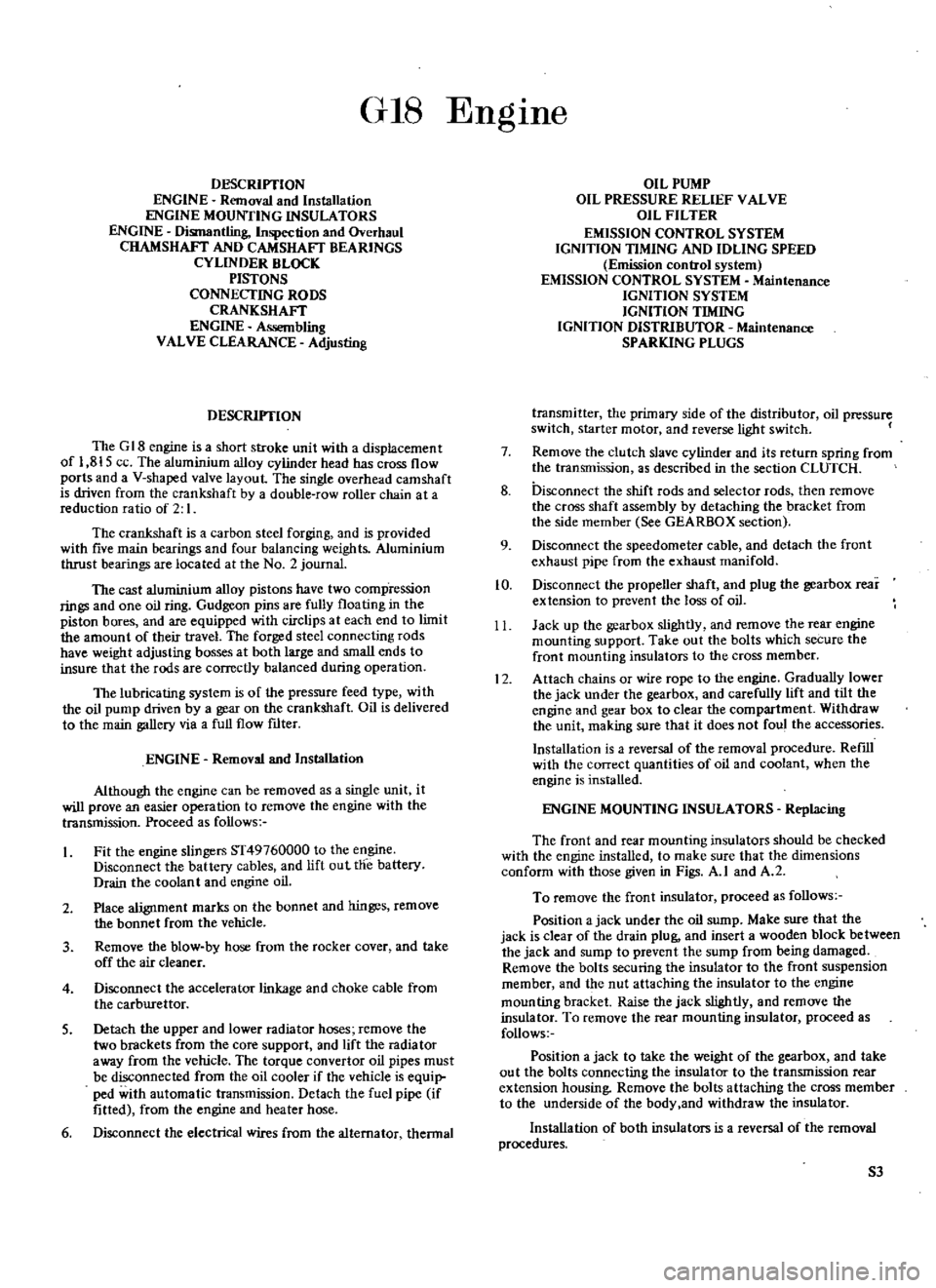
GIS
DESCRIYfION
ENGINE
Removal
and
Installation
ENGINE
MOUNTING
INSULATORS
ENGINE
Dismantling
Inspection
and
Overhaul
CHAMSHAFT
AND
CAMSHAFT
BEARINGS
CYLINDER
BLOCK
PISTONS
CONNECTING
RODS
CRANKSHAFT
ENGINE
Assembling
VALVE
CLEARANCE
Adjusting
DESCRIYfION
The
G
18
engine
is
a
short
stroke
unit
with
a
displacement
of
1
815
ce
The
aluminium
alloy
cylinder
head
has
cross
flow
ports
and
a
V
shaped
valve
layout
The
single
overhead
camshaft
is
driven
from
the
crankshaft
by
a
double
row
roller
chain
at
a
reduction
ratio
of
2
I
The
crankshaft
is
a
carbon
steel
forging
and
is
provided
with
five
main
bearings
and
four
balancing
weights
Aluminium
thrust
bearings
are
located
at
the
No
2
journal
The
cast
aluminium
alloy
pistons
have
two
comp
ression
rings
and
one
oil
ring
Gudgeon
pins
are
fully
floating
in
the
piston
bores
and
are
equipped
with
circlips
at
each
end
to
limit
the
amount
of
their
travel
The
forged
steel
connecting
rods
have
weight
adjusting
bosses
at
both
large
and
small
ends
to
insure
that
the
rods
are
correctly
balanced
during
operation
The
lubricating
system
is
of
the
pressure
feed
type
with
the
oil
pump
driven
by
a
gear
on
the
crankshaft
Oil
is
delivered
to
the
main
gallery
via
a
full
flow
ftlter
ENGINE
Removal
and
Installation
Although
the
engine
can
be
removed
as
a
single
unit
it
will
prove
an
easier
operation
to
remove
the
engine
with
the
transmission
Proceed
as
follows
Fit
the
engine
slingers
ST49760000
to
the
engine
Disconnect
the
battery
cables
and
lift
out
the
battery
Drain
the
coolant
and
engine
oil
2
Place
alignment
marks
on
the
bonnet
and
hinges
remove
the
bonnet
from
the
vehicle
3
Remove
the
blow
by
hose
from
the
rocker
cover
and
take
off
the
air
cleaner
4
Disconnect
the
accelerator
linkage
and
choke
cable
from
the
carburettor
S
Detach
the
upper
and
lower
radiator
hoses
remove
the
two
brackets
from
the
core
support
and
lift
the
radia
tor
away
from
the
vehicle
The
torque
convertor
oil
pipes
must
be
disconnected
from
the
oil
cooler
if
the
vehicle
is
equip
ped
with
automatic
transmission
Detach
the
fuel
pipe
if
fitted
from
the
engine
and
heater
hose
6
Disconnect
the
electrical
wires
from
the
alternator
thennal
EngIne
OIL
PUMP
OIL
PRESSURE
RELIEF
VALVE
OIL
FILTER
EMISSION
CONTROL
SYSTEM
IGNITION
TIMING
AND
IDLING
SPEED
Emission
control
system
EMISSION
CONTROL
SYSTEM
Maintenance
IGNITION
SYSTEM
IGNITION
TIMING
IGNITION
DISTRIBUTOR
Maintenance
SPARKING
PLUGS
transmitter
the
primary
side
of
the
distributor
oil
pressure
switch
starter
motor
and
reverse
light
switch
7
Remove
the
clutch
slave
cylinder
and
its
return
spring
from
the
transmission
as
described
in
the
section
CLUTCH
8
Disconnect
the
shift
rods
and
selector
rods
then
remove
the
cross
shaft
assembly
by
detaching
the
bracket
from
the
side
member
See
GEARBOX
section
9
Disconnect
the
speedometer
cable
and
detach
the
front
exhaust
pipe
from
the
exhaust
manifold
10
Disconnect
the
propeller
shaft
and
plug
the
gearbox
rear
extension
to
prevent
the
loss
of
oil
11
Jack
up
the
gearbox
slightly
and
remove
the
rear
engine
mounting
support
Take
out
the
bolts
which
secure
the
front
mounting
insulators
to
the
cross
member
12
Attach
chains
or
wire
rope
to
the
engine
Gradually
lower
the
jack
under
the
gearbox
and
carefully
lift
and
tilt
the
engine
and
gear
box
to
clear
the
compartment
Withdraw
the
unit
making
sure
that
it
does
not
foul
the
accessories
Installation
is
a
reversal
of
the
removal
procedure
RefIll
with
the
correct
quantities
of
oil
and
coolant
when
the
engine
is
installed
ENGINE
MOUNTING
INSULATORS
Replacing
The
front
and
rear
mounting
insulators
should
be
checked
with
the
engine
installed
to
make
sure
that
the
dimensions
conform
with
those
given
in
Figs
A
I
and
A
2
To
remove
the
front
insulator
proceed
as
follows
Position
a
jack
under
the
oil
sump
Make
sure
that
the
jack
is
clear
of
the
drain
plug
and
insert
a
wooden
block
between
the
jack
and
sump
to
prevent
the
sump
from
being
damaged
Remove
the
bolts
securing
the
insulator
to
the
front
suspension
member
and
the
nut
attaching
the
insulator
to
the
engine
mounting
bracket
Raise
the
jack
slightly
and
remove
the
insulator
To
remove
the
rear
mounting
insulator
proceed
as
follows
Position
a
jack
to
take
the
weight
of
the
gearbox
and
take
out
the
bolts
connecting
the
insulator
to
the
transmission
rear
extension
housing
Remove
the
bolts
attaching
the
cross
member
to
the
underside
of
the
body
and
withdraw
the
insulator
Installation
of
both
insulators
is
a
reversal
of
the
removal
procedures
S3
Page 142 of 171
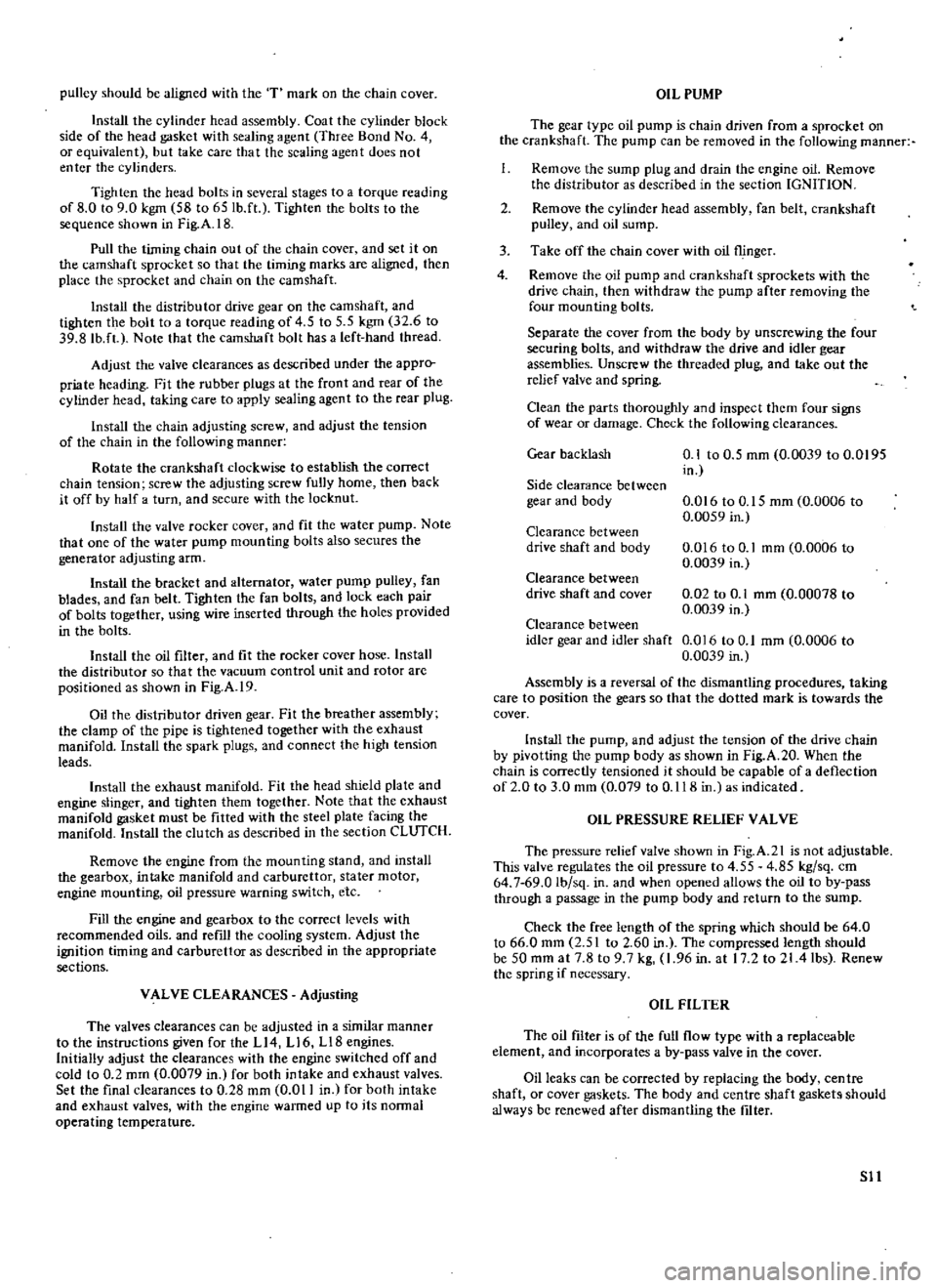
pulley
should
be
aligned
with
the
T
mark
on
the
chain
cover
Install
the
cylinder
head
assembly
Coat
the
cylinder
block
side
of
the
head
gasket
with
sealing
agent
Three
Bond
No
4
or
equivalent
but
take
care
that
the
scaling
agent
does
not
enter
the
cylinders
Tighten
the
head
bolts
in
several
stages
to
a
torque
reading
of
8
0
to
9
0
kgrn
58
to
65
lb
ft
Tighten
the
bolts
to
the
sequence
shown
in
Fig
A
IB
Pull
the
timing
chain
out
of
the
chain
cover
and
set
it
on
the
camshaft
sprocket
so
that
the
timing
marks
are
aligned
then
place
the
sprocket
and
chain
on
the
camshaft
Install
the
distributor
drive
gear
on
the
camshaft
and
tighten
the
bolt
to
a
torque
reading
of
4
5
to
5
5
kgrn
32
6
to
39
8
lb
ft
Note
that
the
camshaft
bolt
has
a
left
hand
thread
Adjust
the
valve
clearances
as
described
under
the
appro
priate
heading
Fit
the
rubber
plugs
at
the
front
and
rear
of
the
cylinder
head
taking
care
to
apply
sealing
agent
to
the
rear
plug
Install
the
chain
adjusting
screw
and
adjust
the
tension
of
the
chain
in
the
following
manner
Rotate
the
crankshaft
clockwise
to
establish
the
correct
chain
tension
screw
the
adjusting
screw
fully
home
then
back
it
off
by
half
a
turn
and
secure
with
the
locknut
Install
the
valve
rocker
cover
and
fit
the
water
pump
Note
that
one
of
the
water
pump
mounting
bolts
also
secures
the
generator
adjusting
arm
Install
the
bracket
and
alternator
water
pump
pulley
fan
blades
and
fan
belt
Tighten
the
fan
bolts
and
lock
each
pair
of
bolts
together
using
wire
inserted
through
the
holes
provided
in
the
bolts
Install
the
oil
filter
and
fit
the
rocker
cover
hose
Install
the
distributor
so
that
the
vacuum
control
unit
and
rotor
arc
positioned
as
shown
in
Fig
A
19
Oil
the
distributor
driven
gear
Fit
the
breather
assembly
the
clamp
of
the
pipe
is
tightened
together
with
the
exhaust
manifold
Install
the
spark
plugs
and
connect
the
high
tension
leads
Install
the
exhaust
manifold
Fit
the
head
shield
plate
and
engine
slinger
and
tighten
them
together
Note
that
the
exhaust
manifold
gasket
must
be
fitted
with
the
steel
plate
facing
the
manifold
Install
the
clutch
as
described
in
the
section
CLUTCH
Remove
the
engine
from
the
mounting
stand
and
install
the
gearbox
intake
manifold
and
carburettor
stater
motor
engine
mounting
oil
pressure
warning
switch
etc
Fill
the
engine
and
gearbox
to
the
correct
levels
with
recommended
oils
and
refill
the
cooling
system
Adjust
the
ignition
timing
and
carburettor
as
described
in
the
appropriate
sections
VALVE
CLEARANCES
Adjusting
The
valves
clearances
can
be
adjusted
in
a
similar
manner
to
the
instructions
given
for
the
L14
LI6
L18
engines
Initially
adjust
the
clearances
with
the
engine
switched
off
and
cold
to
0
2
mm
0
0079
in
for
both
intake
and
exhaust
valves
Set
the
final
clearances
to
0
28
mm
0
011
in
for
both
intake
and
exhaust
valves
with
the
engine
warmed
up
to
its
normal
operating
temperature
OIL
PUMP
The
gear
type
oil
pump
is
chain
driven
from
a
sprocket
on
the
crankshaft
The
pump
can
be
removed
in
the
following
manner
1
Remove
the
sump
plug
and
drain
the
engine
oil
Remove
the
distributor
as
described
in
the
section
IGNITION
2
Remove
the
cylinder
head
assembly
fan
belt
crankshaft
pulley
and
oil
sump
3
Take
off
the
chain
cover
with
oil
fl
inger
4
Remove
the
oil
pump
and
crankshaft
sprockets
with
the
drive
chain
then
withdraw
the
pump
after
removing
the
four
mounting
bolts
Separate
the
cover
from
the
body
by
unscrewing
the
four
securing
bolts
and
withdraw
the
drive
and
idler
gear
assemblies
Unscrew
the
threaded
plug
and
take
out
the
relief
valve
and
spring
Clean
the
parts
thoroughly
and
inspect
them
four
signs
of
wear
or
damage
Check
the
following
clearances
Gear
backlash
0
1
to
0
5
mm
0
0039
to
0
0195
in
Side
clearance
between
gear
and
body
0
016
to
0
15
mm
0
0006
to
0
0059
in
Clearance
between
drive
shaft
and
body
0
016
to
0
1
mm
0
0006
to
0
0039
in
Clearance
between
drive
shaft
and
cover
0
02
to
0
1
mm
0
00078
to
0
0039
in
Clearance
between
idler
gear
and
idler
shaft
0
016
to
0
1
mm
0
0006
to
0
0039
in
Assembly
is
a
reversal
of
the
dismantling
procedures
taking
care
to
position
the
gears
so
that
the
dotted
mark
is
towards
the
cover
Install
the
pump
and
adjust
the
tension
of
the
drive
chain
by
ph
otting
the
pump
body
as
shown
in
Fig
A
20
When
the
chain
is
correctly
tensioned
it
should
be
capable
of
a
deflection
of
2
0
to
3
0
mm
0
079
to
0
118
in
as
indicated
OIL
PRESSURE
RELIEF
VALVE
The
pressure
relief
valve
shown
in
Fig
A
21
is
not
adjustable
This
valve
regulates
the
oil
pressure
to
4
55
4
85
kg
sq
cm
64
7
69
0
lb
sq
in
and
when
opened
allows
the
oil
to
by
pass
through
a
passage
in
the
pump
body
and
return
to
the
sump
Check
the
free
length
of
the
spring
which
should
be
64
0
to
66
0
mm
2
51
to
2
60
in
The
compressed
length
should
be
50
mm
at
7
8
to
9
7
kg
1
96
in
at
17
2
to
21
4Ibs
Renew
the
spring
if
necessary
OIL
FILTER
The
oil
filter
is
of
the
full
flow
type
with
a
replaceable
element
and
incorporates
a
by
pass
valve
in
the
cover
Oil
leaks
can
be
corrected
by
replacing
the
body
centre
shaft
or
cover
gaskets
The
body
and
centre
shaft
gaskets
should
always
be
renewed
after
dismantling
the
filter
S
1
Page 144 of 171

carrying
out
extensive
tests
with
the
necessary
equipment
The
hoses
and
connectors
can
of
course
be
checked
for
signs
of
leakage
and
corrected
as
necessary
Also
the
tension
of
the
air
pump
belt
IGNITION
TIMING
AND
IDLING
SPEED
Emission
control
system
The
ignition
timing
should
be
set
and
the
idling
speed
mixture
adjusted
in
the
folloWing
manner
Run
the
engine
until
it
reaches
its
normal
operating
tem
perature
Connect
an
ignition
tachometer
and
timing
light
observ
ing
the
manufacturers
instructions
NOTE
If
the
vehicle
is
equipped
with
automatic
transmission
make
sure
that
the
dashpot
does
not
prevent
the
throttle
from
closing
Turn
the
throttle
shaft
arm
adjusting
screw
anti
clock
wise
so
that
the
tip
of
the
screw
is
clear
of
the
throttle
shaft
arm
see
Fig
A
26
Turn
the
throttle
adjusting
screw
to
set
the
idling
speed
to
700
r
p
m
650
rpm
for
automatic
transmission
Adjust
the
ignition
timing
to
5
A
T
D
C
Refererence
should
be
made
to
the
instructions
given
in
the
section
IGNITION
SYSTEM
for
the
L14
L16
and
LI8
engines
for
ignition
timing
details
Turn
the
idling
adjustment
screw
and
throttle
adjusting
screw
until
the
engine
runs
smoothly
a
t
the
correct
idling
speed
Turn
the
idling
adjustment
screw
clockwise
until
the
engine
speed
starts
to
drop
as
a
weaker
mix
ture
is
obtained
Now
turn
the
idling
adjustment
screw
anti
clockwise
by
one
turn
one
and
a
half
turns
for
automatic
transmission
to
obtain
a
richer
mix
ture
Adjust
the
idling
speed
to
700
rpm
650
rpm
for
automatic
transmission
by
turning
the
throttle
adjusting
screw
Make
sure
that
the
ignition
timing
remains
at
50
A
T
D
C
Turn
the
throttle
shaft
ann
adjusting
screw
clockwise
until
the
tip
of
the
screw
just
contacts
the
throttle
shaft
ann
The
screw
must
not
exert
pressure
on
the
throttle
shaft
arm
EMISSION
CONTROL
SYSTEM
Maintenance
The
system
should
be
inspected
and
serviced
every
I
2
months
or
20
000
km
12
000
miles
whichever
comes
fIrst
to
make
sure
that
the
exhaust
emissions
are
maintained
at
the
minimum
level
Check
the
carburettor
choke
setting
and
adjust
as
described
in
the
section
FUEL
SYSTEM
Check
the
carburettor
idling
speed
mixture
and
adjust
if
necessary
as
described
under
the
heading
IGNITION
TIMING
AND
IDLING
SPEED
in
this
section
2
Check
the
distributor
earn
dwell
angle
and
also
the
condi
tion
of
the
contact
breaker
points
Check
the
ignition
timing
and
adjust
if
necessary
The
distributor
dwell
angle
should
be
adjusted
to
49
55
degrees
and
the
points
gap
to
0
45
0
55
mm
0
0177
0
0217
in
3
Remove
and
clean
the
sparking
plugs
Renew
any
plug
with
badly
worn
electrodes
Set
the
plug
gaps
to
0
80
0
90
mm
0
0315
0
0355
in
by
adjusting
the
earth
electrode
IGNITION
SYSTEM
The
maintenance
and
servicing
procedures
for
the
compo
nents
of
the
ignition
system
on
vehicles
fitted
with
the
GIS
engine
are
basically
similar
to
the
instructions
previously
given
for
the
Ll4
LI6
and
LIS
engines
The
distributor
is
however
of
a
different
type
Either
an
Hitachi
0416
57
distributor
being
fitted
or
an
Hitachi
0423
53
if
the
vehicle
is
equipped
with
an
emission
control
system
The
distributors
have
different
advance
curve
characteristics
as
shown
in
Technical
Data
IGNITION
TIMING
Check
the
ignition
timing
with
a
timing
light
as
previously
described
for
the
LI4
L16
and
L
8
engines
Disconnect
the
distributor
vacuum
line
and
run
engine
at
idling
speed
or
slightly
below
The
timing
should
be
set
at
8
BTDCj600
rpm
for
the
D416
57
distributor
or
at
5
ATDCj600
rpm
for
the
D423
53
distributor
fItted
to
engines
with
emission
control
systems
IGNITION
DISTRIBUTOR
Maintenance
Maintenance
instructions
are
similar
to
those
given
for
the
L14
LI6
and
L18
engines
Set
the
contact
breaker
points
gap
to
0
45
0
55
mm
0
0177
0
0217
in
as
previously
described
SPARKING
PLUGS
The
sparking
plugs
should
be
inspected
and
cleaned
at
regular
intervals
and
renewed
at
approximately
20
000
kIn
12
000
miles
Clean
the
plugs
thoroughly
and
make
sure
they
are
of
the
same
type
and
heat
range
File
the
centre
electrode
nat
before
adjusting
the
gap
Set
the
gap
to
0
8
0
9mm
0
031
0
035
in
if
the
engine
is
fItted
with
emission
control
system
or
to
0
7
0
8
mm
0
028
0
031
in
if
emission
control
is
not
fitted
Adjustment
must
always
be
made
by
bending
the
earth
electrode
TechnIcal
Data
GENERAL
SPECIFICATION
GI8
Engine
Cylinders
Bore
and
stroke
Displacemen
t
Valve
arrangemen
t
Firing
order
Engine
idler
speed
Compression
ratio
Oil
pressure
at
3000
r
p
m
4
in
line
85x80
mm
3
346x3
150
in
1
815
cc
110
8
cu
in
OHC
134
2
600
r
p
m
STD
8
3
I
4
7
to
5
5
kgjsq
cm
66
8
to
78
2
Ibjsq
in
LIQUID
PACKING
APPLICATION
Cylinder
block
2
Cylinder
head
Oil
gallery
blind
plug
Expansion
plug
Gas
breather
guide
Rear
bearing
cap
fitting
surface
Rear
bearing
cap
side
seal
both
ends
Expansion
plug
Rubber
plug
Rea
Manifold
heat
pipe
3
Chain
cover
gasket
both
sides
S13
Page 147 of 171
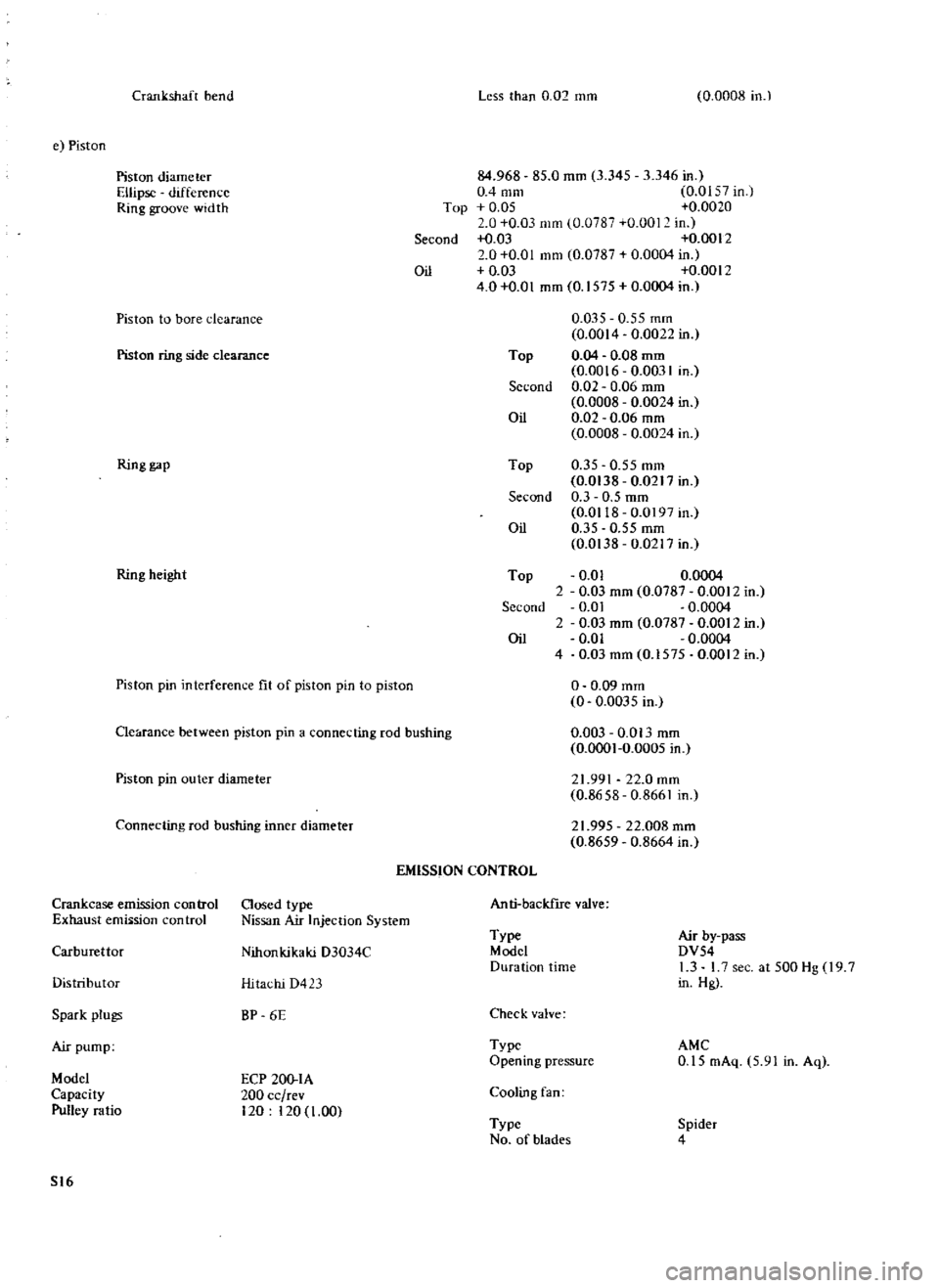
Crank
shaf
bend
Less
than
0
02
mm
0
0008
in
e
Piston
Pis
on
diameter
Ellipse
difference
Ring
groove
wid
h
84
968
85
0
mm
3
345
3
346
in
0
4
mm
0
01
7
in
Top
0
05
0
0020
0
0
03
mm
0
0787
0
001
in
Second
I
03
0
0012
2
0
0
01
mm
0
0787
0
0004
in
Oil
0
03
0
0012
4
0
0
01
mm
0
1575
0
0004
in
Piston
ring
side
clearance
0
035
0
55
mm
0
0014
0
0022
in
Top
0
04
0
08
mID
0
0016
0
0031
in
Second
0
02
0
06
mm
0
0008
0
0024
in
Oil
0
02
0
06
mm
0
0008
0
0024
in
Piston
to
bore
clearance
Ring
gap
Top
0
35
0
55
mm
0
0138
0
0217
in
Second
0
3
0
5
mm
0
0118
0
0197
in
Oil
0
35
0
55
mm
0
0138
0
0217
in
Top
0
01
0
0004
2
0
03
mm
0
0787
0
0012
in
Second
0
01
0
0004
2
0
03
mm
0
0787
0
0012
in
Oil
0
Q1
0
0004
4
0
03mm
0
I575
0
0012in
Ring
height
Piston
pin
interferenl
c
fit
of
piston
pin
to
piston
o
0
09
mm
0
0
0035
in
0
003
0
013
mm
0
0001
0
0005
in
Clearance
between
piston
pin
a
connecting
rod
bushing
Piston
pin
outer
diameter
21
991
22
0
mm
0
8658
0
8661
in
Connecting
rod
bushing
inner
diameter
21
995
22
008
mm
0
8659
0
8664
in
EMISSION
CONTROL
Crankcase
emission
con
trol
Closed
type
Exhaust
emiision
control
Nissan
Air
Injec
ion
System
Anti
backIrre
valve
Carburettor
Nihonkikaki
D3034C
Type
Model
Duration
time
Air
by
pass
DV54
1
3
L7
sec
at
500
Hg
9
7
in
Hg
Distribu
or
Hitachi
D423
Spark
plugs
BP
6E
Check
valve
Air
pump
Type
Opening
pressure
AMC
0
15
mAq
5
91
in
Aq
Model
Capacity
Pulley
ratio
ECP
20Q
IA
200
cc
rev
120
120
1
00
Cooling
fan
Type
No
of
blades
Spider
4
S16
Page 148 of 171

Fan
coupling
Pulley
ratio
fan
and
water
pump
Tuning
data
Basic
timing
Idling
speed
Distributor
dwell
angle
Spark
plug
gap
Choke
setting
CO
percent
setting
Fan
rpm
water
pump
rpm
3
300
4
000
120
103
Ll71
50
A
T
D
C
700
rpm
650
rpm
automatic
490
550
at
0
02
in
breaker
gap
0
8IJ
0
90
mm
0
03
I
5
0
0355
in
Manual
6
0
I
0
5
air
supply
hose
disconnected
Air
pump
drive
belt
tensioning
Permissible
slackness
of
8
0
12
0
mm
0
3
15
0
4
72
in
under
a
load
of7
1O
kg
1
54
2
20
lb
IGNITION
SYSTEM
DISTRIBUTOR
Type
Firing
order
Rotation
Igntion
timing
Without
emission
control
With
emission
control
Dwell
angle
Condenser
capacity
Advance
characteristics
D416
57
distributor
Hitachi
D416
57
Hitachi
D423
53
with
emission
control
system
134
2
Anti
clockwise
80
B
T
D
C
at
600
rpm
50
A
T
D
C
at
600
r
p
m
49
to
55
degreos
0
20
0
24
1
F
Centrifugal
Start
Maximum
degree
r
p
m
Vacuum
Start
Maximum
degree
r
p
m
Advance
characteristics
D423
53
distributor
Centrifugal
Start
Maximum
degree
r
p
m
Vacuum
Start
Maximum
degree
r
p
m
IGNITION
COIL
Type
Primary
voltage
Spark
gap
Primary
resistance
Secondary
resistance
SPARKING
PLUGS
Type
Gap
Fuel
Systenl
DESCRIPTION
FUEL
PUMP
Testing
FUEL
PUMP
Removing
and
Dismantling
CARBURETTOR
Idling
adjustment
FUEL
LEVEL
Adjusting
STARTING
INTERLOCK
VALVE
OPENING
THROTTLE
VALVE
INTERLOCK
OPENING
CARBURETIOR
Removing
and
Dismantling
DESCRIPTION
A
dual
barrel
down
draught
type
carburettor
is
fitted
to
vehicles
with
the
G
18
engine
A
Stromberg
type
D3034C
carburet
tor
is
installed
on
engines
with
exhaust
emission
controL
and
a
Solex
type
DAK340
carburettor
on
engines
not
equipped
with
this
type
of
system
Both
types
of
carburettors
incorporate
a
550
r
p
m
01
50
at
I
400
16
50
at
2
800
80
mmHg
6
50
at
200
r
p
m
475
r
p
m
01
50
at
1
000
23
50
at
2
600
80
mm
Hg
30
at
120
r
p
m
go
at
400
r
p
m
Hanshin
HM
12F
or
HP5
I
OE
with
emission
control
system
12
volts
more
than
6
mm
0
2362
in
3
8
ohms
at
200C
I
1
2
I
6
8
ohms
at
200
C
NGK
BP
6E
0
7
0
8
mm
0
028
0
031
in
or
0
80
9
mm
0
031
0
035
in
with
emission
control
system
primary
system
for
normal
running
and
a
secondary
system
for
full
load
running
a
float
assembly
which
supplies
fuel
to
both
primary
and
secondary
systems
a
starting
mechanism
and
accelerator
pump
which
provides
a
richer
mixture
on
accelera
tion
SI7
Page 150 of 171
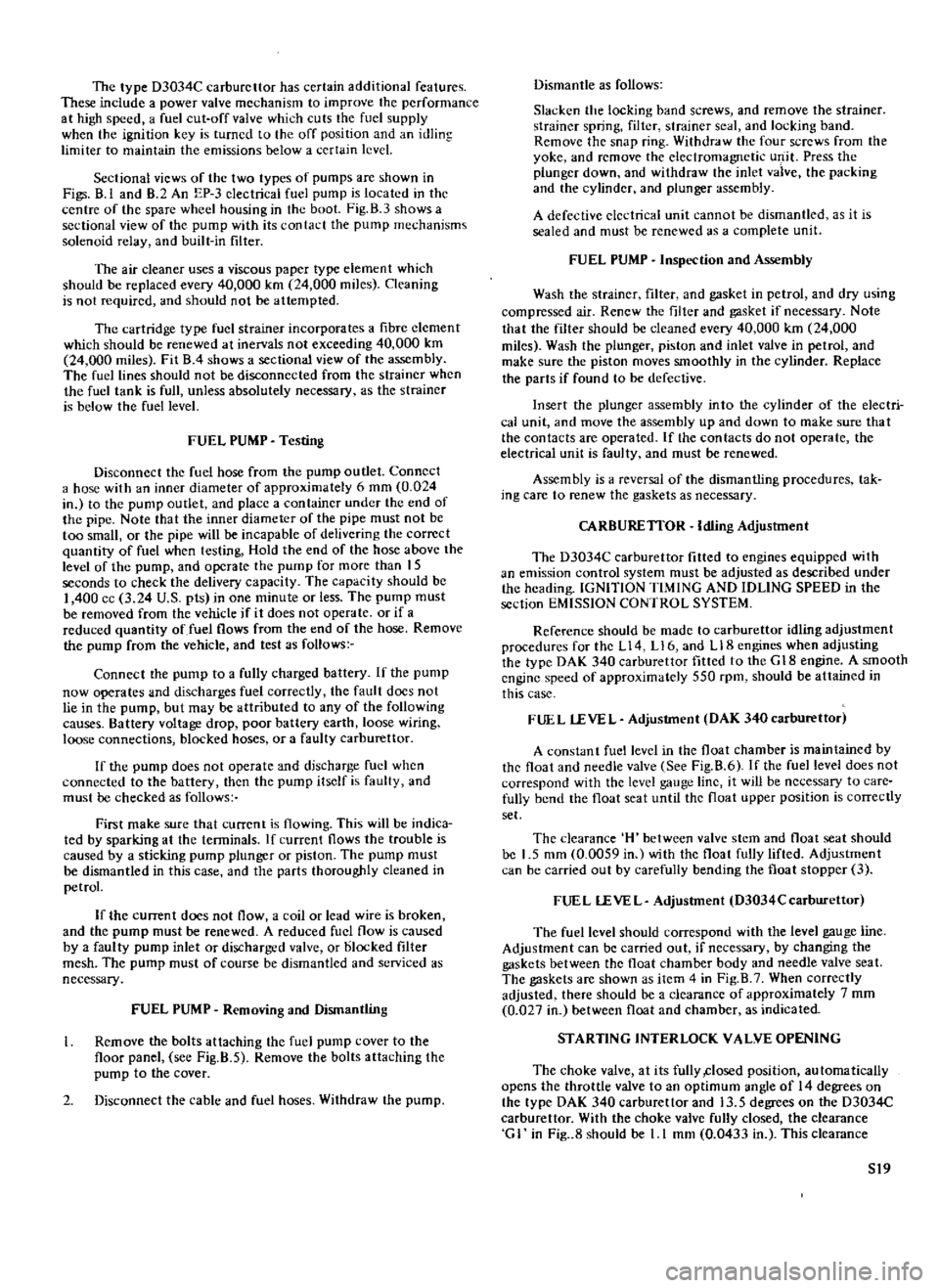
The
type
D3034C
carburettor
has
certain
additional
features
These
include
a
power
valve
mechanism
to
improve
the
performance
at
high
speed
a
fuel
cut
off
valve
which
cuts
the
fuel
supply
when
the
ignition
key
is
turned
to
the
off
position
and
an
idling
limiter
to
maintain
the
emissions
below
a
certain
level
Sectional
views
of
the
two
types
of
pumps
are
shown
in
Figs
8
1
and
B
2
An
EP
3
electrical
fuel
pump
is
located
in
the
centre
of
the
spare
wheel
housing
in
the
boot
Fig
B
3
shows
a
sectional
view
of
the
pump
with
its
contact
the
pump
mechanisms
solenoid
relay
and
built
in
filter
The
air
cleaner
uses
a
viscous
paper
type
element
which
should
be
replaced
every
40
000
km
24
000
miles
Cleaning
is
not
required
and
should
not
be
attempted
The
cartridge
type
fuel
strainer
incorporates
a
fibre
clement
which
should
be
renewed
at
inervals
not
exceeding
40
000
km
24
000
miles
Fit
B
4
shows
a
sectional
view
of
the
assembly
The
fuel
lines
should
not
be
disconnected
from
the
strainer
when
the
fuel
tank
is
full
unless
absolutely
necessary
as
the
strainer
is
below
the
fuel
level
FUEL
PUMP
Testing
Disconnect
the
fuel
hose
from
the
pump
outlet
Connect
a
hose
with
an
inner
diameter
of
approximately
6
mm
0
024
in
to
the
pump
outlet
and
place
a
container
under
the
end
of
the
pipe
Note
that
the
inner
diameter
of
the
pipe
must
not
be
too
small
or
the
pipe
will
be
incapable
of
delivering
the
correct
quantity
of
fuel
when
testing
Hold
the
end
of
the
hose
above
the
level
of
the
pump
and
operate
the
pump
for
more
than
IS
seconds
to
check
the
delivery
capacity
The
capacity
should
be
I
400
cc
3
24
U
S
pts
in
one
minute
or
less
The
pump
must
be
removed
from
the
vehicle
if
it
does
not
operate
or
if
a
reduced
quantity
of
fuel
flows
from
the
end
of
the
hose
Remove
the
pump
from
the
vehicle
and
test
as
follows
Connect
the
pump
to
a
fully
charged
battery
If
the
pump
now
operates
and
discharges
fuel
correctly
the
fault
does
not
lie
in
the
pump
but
may
be
attributed
to
any
of
the
following
causes
Battery
voltage
drop
poor
battery
earth
loose
wiring
loose
connections
blocked
hoses
or
a
faulty
carburettor
If
the
pump
does
not
operate
and
discharge
fuel
when
connected
to
the
battery
then
the
pump
itself
is
faulty
and
must
be
checked
as
follows
First
make
sure
that
current
is
flowing
This
will
be
indica
ted
by
sparking
at
the
tenninals
If
current
flows
the
trouble
is
caused
by
a
sticking
pump
plunger
or
piston
The
pump
must
be
dismantled
in
this
case
and
the
parts
thoroughly
cleaned
in
petrol
If
the
current
does
not
flow
a
coil
or
lead
wire
is
broken
and
the
pump
must
be
renewed
A
reduced
fuel
flow
is
caused
by
a
faulty
pump
inlet
or
discharged
valve
or
blocked
filter
mesh
The
pump
must
of
course
be
dismantled
and
serviced
as
necessary
FUEL
PUMP
Removing
and
Dismantling
Remove
the
bolts
attaching
the
fuel
pump
cover
to
the
floor
panel
see
Fig
B
S
Remove
the
bolts
attaching
the
pump
to
the
cover
2
Disconnect
the
cable
and
fuel
hoses
Withdraw
the
pump
Dismantle
as
follows
Slacken
the
locking
band
screws
and
remove
the
strainer
strainer
spring
filter
strainer
seal
and
locking
band
Remove
the
snap
ring
Withdraw
the
four
screws
from
the
yoke
and
remove
the
electromagnetic
ulJ
it
Press
the
plunger
down
and
withdraw
the
inlet
vaive
the
packing
and
the
cylinder
and
plunger
assembly
A
defective
eledrical
unit
cannot
be
dismantled
as
it
is
sealed
and
must
be
renewed
as
a
complete
unit
FUEL
PUMP
Inspection
and
Assembly
Wash
the
strainer
filter
and
gasket
in
petrol
and
dry
using
compressed
air
Renew
the
filter
and
gasket
if
necessary
Note
that
the
filter
should
be
cleaned
every
40
000
km
24
000
miles
Wash
the
plunger
piston
and
inlet
valve
in
petrol
and
make
sure
the
piston
moves
smoothly
in
the
cylinder
Replace
the
parts
if
found
to
be
defective
Insert
the
plunger
assembly
into
the
cylinder
of
the
electri
cal
unit
and
move
the
assembly
up
and
down
to
make
sure
tha
t
the
contacts
are
operated
If
the
contacts
do
not
operate
the
electrical
unit
is
faulty
and
must
be
renewed
Assembly
is
a
reversal
of
the
dismantling
procedures
tak
ing
care
to
renew
the
gaskets
as
necessary
CARBURETIOR
Idling
Adjustment
The
D3034C
carburettor
fitted
to
engines
equipped
with
an
emission
control
system
must
be
adjusted
as
described
under
the
heading
IGNITION
TIMING
AND
IDLING
SPEED
in
the
section
EMISSION
CONTROL
SYSTEM
Reference
should
be
made
to
carburettor
idling
adjustment
procedures
for
the
L14
L16
and
LI8
engines
when
adjusting
the
type
DAK
340
carburettor
fitted
to
the
G
18
engine
A
smooth
engine
speed
of
approximately
550
rpm
should
be
attained
in
this
case
FUEL
lEVEL
Adjustment
DAK
340earburettor
A
constant
fuellevcl
in
the
float
chamber
is
maintained
by
the
float
and
needle
valve
See
Fig
8
6
If
the
fuel
level
does
not
correspond
with
the
level
gauge
line
it
will
be
necessary
to
care
fully
bend
the
float
seat
until
the
float
upper
position
is
correctly
set
The
clearance
H
between
valve
stem
and
float
seat
should
be
I
5
mm
0
0059
in
with
the
float
fully
lifted
Adjustment
can
be
carried
out
by
carefully
bending
the
float
stopper
3
FUEL
lEVEL
Adjustment
D3034Ccarburettnr
The
fuel
level
should
correspond
with
the
level
gauge
line
Adjustment
can
be
carried
out
if
necessary
by
changing
the
gaskets
between
the
float
chamber
body
and
needle
valve
seat
The
gaskets
are
shown
as
item
4
in
Fig
B
7
When
correctly
adjusted
there
should
be
a
clearance
of
approximately
7
mm
0
027
in
between
float
and
chamber
as
indicated
STARTING
INTERLOCK
VALVE
OPENING
The
choke
valve
at
its
fully
closed
position
automatically
opens
the
throttle
valve
to
an
optimum
angle
of
14
degrees
on
the
type
DAK
340
carburettor
and
13
5
degrees
on
the
D3034C
carburettor
With
the
choke
valve
fully
closed
the
clearance
G
I
in
Fig
8
should
be
1
I
mm
0
0433
in
This
clearance
S19
Page 154 of 171
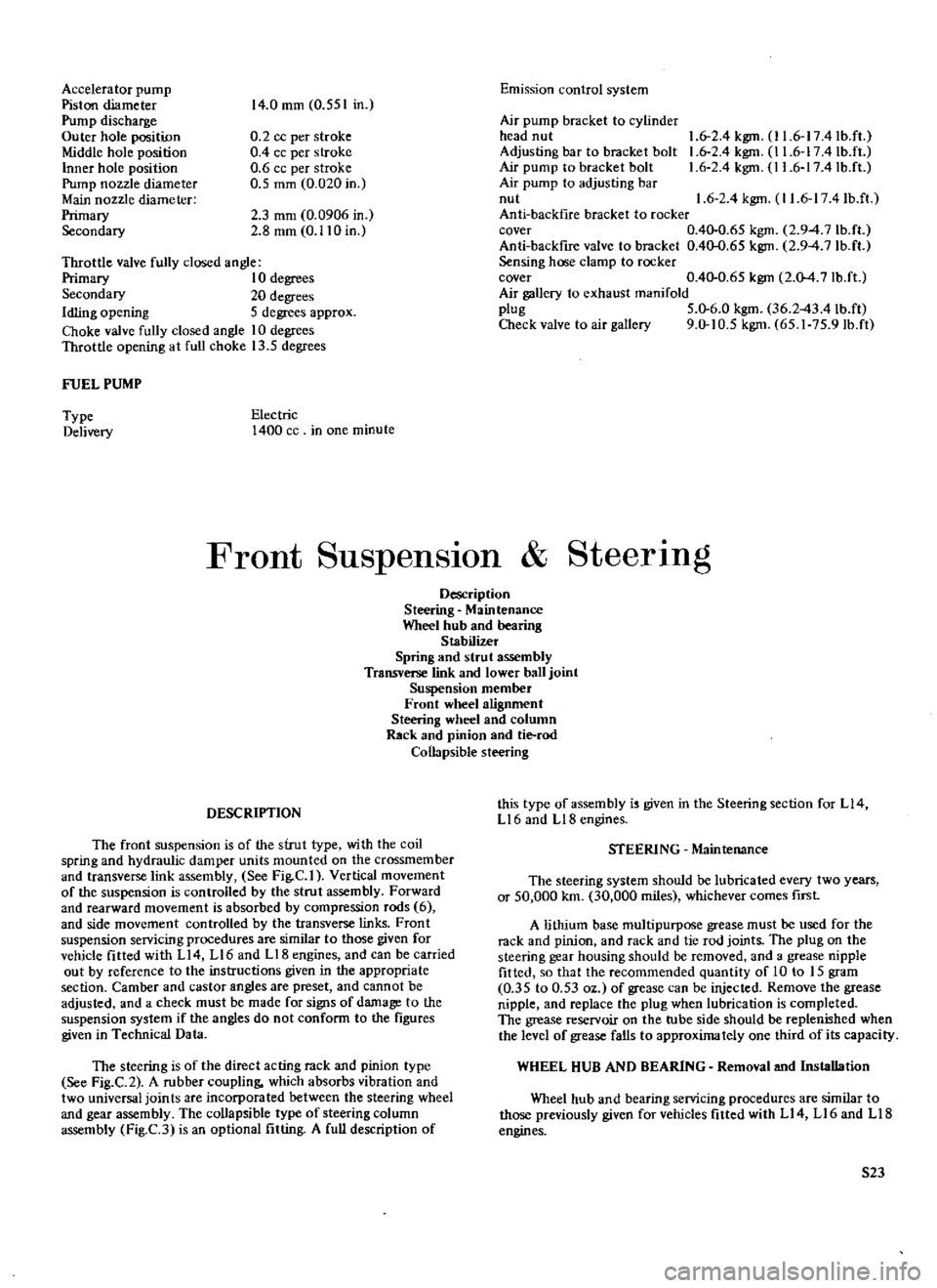
Accelerator
pump
Piston
diameter
Pump
discharge
Outer
hole
position
Middle
hole
position
Inner
hole
position
Pump
nozzle
diameter
Main
nozzle
diameter
Primary
Secondary
14
0
mm
0
551
in
0
2
cc
per
stroke
0
4
cc
per
stroke
0
6
cc
per
stroke
0
5
mm
0
020
in
2
3
mm
0
0906
in
2
8
mm
0
110
in
Throttle
valve
fully
closed
angle
Primary
10
degrees
Secondary
20
degrees
Idling
opening
5
degrees
approx
Choke
valve
fully
closed
angle
10
degrees
Throttle
opening
at
full
choke
13
5
degrees
FUEL
PUMP
Type
Delivery
Electric
1400
cc
in
one
minute
Emission
control
system
Air
pump
bracket
to
cylinder
head
nut
Adjusting
bar
to
bracket
bolt
Air
pump
to
bracket
bolt
Air
pump
to
adjusting
bar
nut
Anti
backfrre
bracket
to
rocker
cover
0
4Q
0
65
kgm
2
94
7
lb
ft
Anti
backfire
valve
to
bracket
0
4Q
O
65
kgm
2
94
7
lb
ft
Sensing
hose
clamp
to
rocker
cover
0
4Q
0
65
kgm
2
M
7
Ib
ft
Air
gallery
to
exhaust
manifold
plug
5
Q
6
0
kgm
36
243
4lb
ft
Check
valve
to
air
gallery
9
0
10
5
kgm
65
1
75
9Ib
ft
1
6
2
4
kgm
I
1
6
17
4Ib
ft
1
6
2
4
kgm
I
1
6
17
4Ib
ft
1
6
2
4
kgm
I
1
6
17
4
lb
ft
1
6
2
4
kgm
11
6
17
4Ib
ft
Front
SuspensIon
SteerIng
Description
Steering
Maintenance
Wheel
hub
and
bearing
Stabilizer
Spring
and
strut
assembly
Transverse
link
and
lower
ball
joint
Suspension
member
Front
wheel
alignment
Steering
wheel
and
column
Rack
and
pinion
and
tie
rod
Collapsible
steering
DESCRIPTION
The
front
suspension
is
of
the
strut
type
with
the
coil
spring
and
hydraulic
damper
units
mounted
on
the
crossmember
and
transverse
link
assembly
See
Fig
C
I
Vertical
movement
of
the
suspension
is
controlled
by
the
strut
assembly
Forward
and
rearward
movement
is
absorbed
by
compression
rods
6
and
side
movement
controlled
by
the
transverse
links
Front
suspension
servicing
procedures
are
similar
to
those
given
for
vehicle
fitted
with
L14
Ll6
and
LIB
engines
and
can
be
carried
out
by
reference
to
the
instructions
given
in
the
appropriate
section
Camber
and
castor
angles
are
preset
and
cannot
be
adjusted
and
a
check
must
be
made
for
signs
of
damage
to
the
suspension
system
if
the
angles
do
not
confonn
to
the
figures
given
in
Technical
Data
The
steering
is
of
the
direct
acting
rack
and
pinion
type
See
Fig
C
2
A
rubber
coupling
which
absorbs
vibration
and
two
universal
join
ts
are
incorpora
ted
between
the
steering
wheel
and
gear
assembly
The
collapsible
type
of
steering
column
assembly
Fig
C3
is
an
optional
fitting
A
full
description
of
this
type
of
assembly
i
given
in
the
Steering
section
for
L14
L16
and
L18
engines
STEERING
Maintenance
The
steering
system
should
be
lubricated
every
two
years
or
50
000
km
30
000
miles
whichever
comes
fIrst
A
lithium
base
multipurpose
grease
must
be
used
for
the
rack
and
pinion
and
rack
and
tie
rod
joints
The
plug
on
the
steering
gear
housing
should
be
removed
and
a
grease
nipple
fitted
so
that
the
recommended
quantity
of
10
to
15
gram
0
35
to
0
53
oz
of
grease
can
be
injected
Remove
the
grease
nipple
and
replace
the
plug
when
lubrication
is
completed
The
grease
reservoir
on
the
tube
side
should
be
replenished
when
the
level
of
grease
falls
to
approximately
one
third
ofits
capacity
WHEEL
HUB
AND
BEARING
Removal
and
Installation
Wheel
hub
and
bearing
servicing
procedures
are
similar
to
those
previously
given
for
vehicles
fitted
with
L14
LI6
and
LIB
engines
S23
Page 160 of 171
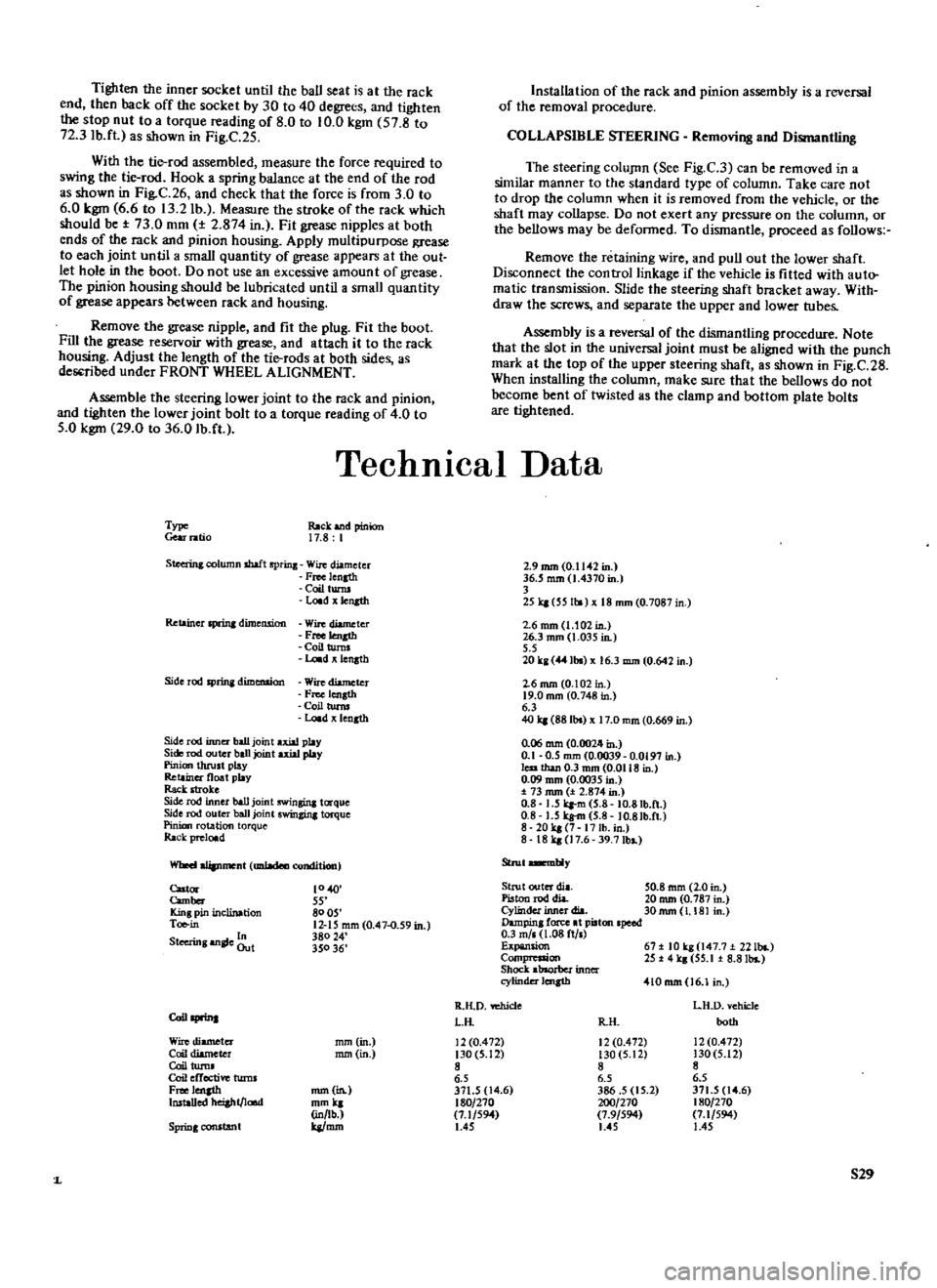
Tighten
the
inner
socket
until
the
ball
seat
is
at
the
rack
end
then
back
off
the
socket
by
30
to
40
degrees
and
tighten
the
stop
nut
to
a
torque
reading
of
8
0
to
10
0
kgm
57
8
to
72
3
Ib
ft
as
shown
in
Fig
C
25
With
the
tie
rod
assembled
measure
the
force
required
to
swing
the
tie
rod
Hook
a
spring
balance
at
the
end
of
the
rod
as
shown
in
Fig
C
26
and
check
that
the
force
is
from
3
0
to
6
0
kgm
6
6
to
13
2
lb
Measure
the
stroke
of
the
rack
which
should
be
73
0
mm
2
874
in
Fit
grease
nipples
at
both
ends
of
the
rack
and
pinion
housing
Apply
multipurpose
ase
to
each
joint
until
a
small
quantity
of
grease
appears
at
the
out
let
hole
in
the
boot
Do
not
use
an
excessive
amount
of
grease
The
pinion
housing
should
be
lubricated
until
a
small
quantity
of
grease
appears
between
rack
and
housing
Remove
the
grease
nipple
and
fit
the
plug
Fit
the
boot
Fill
the
grease
reseIVoir
with
grease
and
attach
it
to
the
rack
housing
Adjust
the
length
of
the
tie
rods
at
both
sides
as
des
ribed
under
FRONT
WHEEL
ALIGNMENT
Assemble
the
steering
lower
joint
to
the
rack
and
pinion
and
tighten
the
lower
joint
bolt
to
a
torque
reading
of
4
0
to
5
0
kgm
29
0
to
36
0
Ib
ft
Installation
of
the
rack
and
pinion
assembly
is
a
reversal
of
the
removal
procedure
COLLAPSIBLE
STEERING
Removi
8
and
Dismantti
8
The
steering
coluJllfl
See
Fig
C
3
can
be
removed
in
a
similar
manner
to
the
standard
type
of
column
Take
care
not
to
drop
the
column
when
it
is
removed
from
the
vehicle
or
the
shaft
may
collapse
Do
not
exert
any
pressure
on
the
column
or
the
bellows
may
be
defonned
To
dismantle
proceed
as
follows
Remove
the
retaining
wire
and
pull
out
the
lower
shaft
Disconnect
the
control
linkage
if
the
vehicle
is
fitted
with
auto
matic
transmission
Slide
the
steering
shaft
bracket
away
With
draw
the
screws
and
separate
the
upper
and
lower
tubes
Assembly
is
a
reversal
of
the
dismantling
procedure
Note
that
the
slot
in
the
universal
joint
must
be
aligned
with
the
punch
mark
at
the
top
of
the
upper
steering
shaft
as
shown
in
Fig
C
28
When
installing
the
column
make
sure
that
the
bellows
do
not
become
bent
of
twisted
as
the
clamp
and
bottom
plate
bolts
are
tightened
TechnICal
Data
TYP
Gear
I1ltio
Rack
and
pinion
17
8
I
Steerin
column
shaft
spring
Wire
diameter
Freelenath
CoiltW
llJ
Load
length
Retainer
sprinJ
dimension
Wire
diameter
F
CoilturnJ
l
oadxlensth
Side
rod
SPrina
dimeruion
Wire
diameter
Fn
elenath
Coil
turns
Load
x
lensth
Side
rod
inner
ball
joint
ax
ia
I
play
Side
rod
outer
ball
joint
uiaJ
play
Pinion
thrultplay
Retainer
float
play
Rack
moke
Side
rod
inner
ball
joint
swinsinl
torque
Side
rod
uter
ball
joint
swingina
torque
Pinion
oration
torque
Rack
pre1
d
Wheel
alipment
1IIl1a
a
ondition
Cut
c
m
Kinl
pin
inclination
Toe
in
S
In
teerinlan
eOut
10
40
8005
12
15
mm
0
47
0
59
in
38024
35036
2
9
mm
0
11
2
in
36
5
mm
1
4370
in
3
25q
551
18mm
0
7087
2
6
mm
1
102in
26
3
mm
1
035
in
5
5
20
kl
lbs
16
3
mm
0
642
in
26
mm
0
102
in
19
0
mm
0
748
in
6
3
40
q
88Ibs
17
0
mm
0
669
in
0
06
mm
0
002
m
0
1
0
5
mm
0
0039
0
0197
in
less
than
0
3
mm
0
0118
in
0
09
mm
0
0035
in
73
mm
t
2
87
in
0
8
1
5
q
m
5
8
10
8Ib
n
0
8
J
S
kg
m
5
8
JO
8Ib
ft
8
20q
7
17
lb
in
8
18
q
l7
6
39
7Ibs
Strut
DlelDbly
Strut
outer
Ilia
50
8
mm
2
0
in
Piston
rod
di
a
20
mm
0
787
in
Cylinder
inner
dia
30mm
I
181
in
Dampinl
force
at
pistonlpeed
0
3
m
I
1
08
ft
I
Expansion
67
IOq
I47
7
221bs
Compression
25
4kl
55
1
8
81bs
Shock
absorber
inner
cylinderlcngth
IOmm
16
1
in
R
IlD
vchicle
LH
D
ehide
CoiIsprina
LIi
IlIi
OOIh
Wire
diameter
mm
in
12
0
472
12
0
472
12
0
472
Coil
diameter
mm
in
130
5
12
130
5
12
130
5
12
Coil
Ium
S
Coil
effective
turnl
6
5
6
5
6
5
Free
lenJth
mm
in
371
5
14
6
386
5
15
2
371
5
14
6
Installed
hei
ht
load
mmq
180
270
200
270
180
270
in
lb
7
1
594
7
9
594
7
1
594
SpriDgCOfl
ltant
ka
mm
1
45
US
1
45
529
1
Page 162 of 171
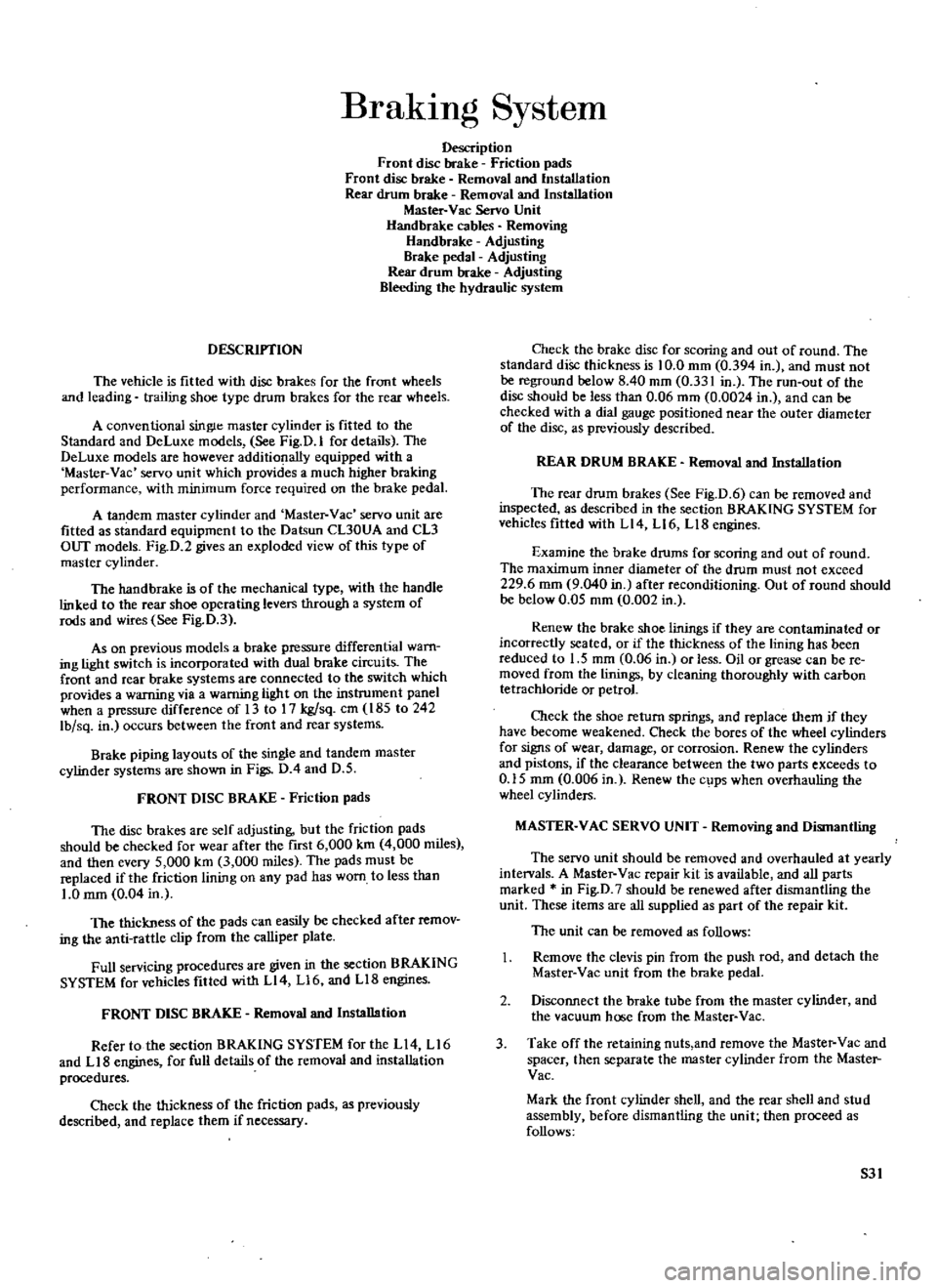
BrakIng
System
Description
Front
disc
brake
Friction
pads
Front
disc
brake
Removal
and
Installation
Rear
drum
brake
Removal
and
Installation
Master
Vac
Servo
Unit
Handbrake
cables
Removing
Handbrake
Adjusting
Brake
pedal
Adjusting
Rear
drum
brake
Adjusting
Bleeding
the
hydraulic
system
DESCRIPTION
The
vehicle
is
fitted
with
disc
brakes
for
the
front
wheels
and
leading
trailing
shoe
type
drum
brakes
for
the
rear
wheels
A
conventional
single
master
cylinder
is
fitted
to
the
Standard
and
DeLuxe
models
See
Fig
D
I
for
details
The
DeLuxe
models
are
however
additio
ally
equipped
with
a
Master
Vae
servo
unit
which
provides
a
much
higher
braking
performance
with
minimum
force
required
on
the
brake
pedal
A
tandem
master
cylinder
and
Master
Vac
servo
unit
are
fitted
as
standard
equipment
to
the
Datsun
CL30UA
and
CL3
OUT
models
Fig
D
2
gives
an
exploded
view
of
this
type
of
master
cylinder
The
handbrake
is
of
the
mechanical
type
with
the
handle
linked
to
the
rear
shoe
operating
lever
through
a
system
of
rods
and
wires
See
Fig
D
3
As
on
previous
models
a
brake
pressure
differential
warn
ing
light
switch
is
incorporated
with
dual
brake
circuits
The
front
and
rear
brake
systems
are
connected
to
the
switch
which
provides
a
warning
via
a
warning
light
on
the
instnllnent
panel
when
a
pressure
difference
of
13
to
17
kg
sq
cm
IB5
to
242
lb
sq
in
occurs
between
the
front
and
rear
systems
Brake
piping
layouts
of
the
single
and
tandem
master
cylinder
systems
are
shown
in
Figs
D
4
and
0
5
FRONT
DISC
BRAKE
Friction
pads
The
disc
brakes
are
self
adjusting
but
the
friction
pads
should
be
checked
for
wear
after
the
fIrst
6
000
un
4
000
miles
and
then
every
5
000
km
3
000
miles
The
pads
must
be
replaced
if
the
friction
lining
on
any
pad
has
worn
to
less
than
1
0
mm
0
04
in
The
thickness
of
the
pads
can
easily
be
checked
after
remov
ing
the
anti
rattle
clip
from
the
calliper
plate
Full
servicing
procedures
are
given
in
the
section
BRAKING
SYSTEM
for
vehicles
fitted
with
Ll4
Ll6
and
Ll8
engines
FRONT
DISC
BRAKE
Removal
and
Installation
Refer
to
the
section
BRAKING
SYSTEM
for
the
Ll4
L16
and
LIB
engines
for
full
details
of
the
removal
and
installation
procedures
Check
the
thickness
of
the
friction
pads
as
previously
described
and
replace
them
if
necessary
Check
the
brake
disc
for
scoring
and
out
of
round
The
standard
diSc
thickness
is
10
0
mm
0
394
in
and
must
not
be
reground
below
8
40
mm
0
331
in
The
run
out
of
the
disc
should
be
less
than
0
06
mm
0
0024
in
and
can
be
checked
with
a
dial
gauge
positioned
near
the
outer
diameter
of
the
disc
as
previously
described
REAR
DRUM
BRAKE
Removal
and
Installation
The
rear
drum
brakes
See
Fig
D
6
can
be
removed
and
inspected
as
described
in
the
section
BRAKING
SYSTEM
for
vehicles
fItted
with
L14
L16
LIB
engines
Examine
the
brake
drums
for
scoring
and
out
of
round
The
maximum
inner
diameter
of
the
drum
must
not
exceed
229
6
mm
9
040
in
after
reconditioning
Out
of
round
should
be
below
0
05
mm
0
002
in
Renew
the
brake
shoe
linings
if
they
are
contaminated
or
incorrectly
seated
or
if
the
thickness
of
the
lining
has
been
reduced
to
1
5
mm
0
06
in
or
less
Oil
or
grease
can
be
re
moved
from
the
linings
by
cleaning
thoroughly
with
carbon
tetrachloride
or
petrol
Check
the
shoe
return
springs
and
replace
them
if
they
have
become
weakened
Check
the
bores
of
the
wheel
cylinders
for
signs
of
wear
damage
or
corrosion
Renew
the
cylinders
and
pistons
if
the
clearance
between
the
two
parts
exceeds
to
0
15
mm
0
006
in
Renew
the
c
ps
when
overhauling
the
wheel
cylinders
MASTER
V
AC
SERVO
UNIT
Removing
and
Dismantling
The
servo
unit
should
be
removed
and
overhauled
at
yearly
intervals
A
Master
Vac
repair
kit
is
available
and
all
parts
marked
in
Fig
D
7
should
be
renewed
after
dismantling
the
unit
These
items
are
all
supplied
as
part
of
the
repair
kit
The
unit
can
be
removed
as
follows
Remove
the
clevis
pin
from
the
push
rod
and
detach
the
Master
V
ac
unit
from
the
brake
pedal
2
Disconnect
the
brake
tube
from
the
master
cylinder
and
the
vacuum
hooe
from
the
Master
Vac
3
Take
off
the
retaining
nuts
and
remove
the
Master
Vac
and
spacer
then
separate
the
master
cylinder
from
the
Master
Vac
Mark
the
front
cylinder
shell
and
the
rear
shell
and
stud
assembly
before
dismantling
the
unit
then
proceed
as
follows
S31
Page 168 of 171
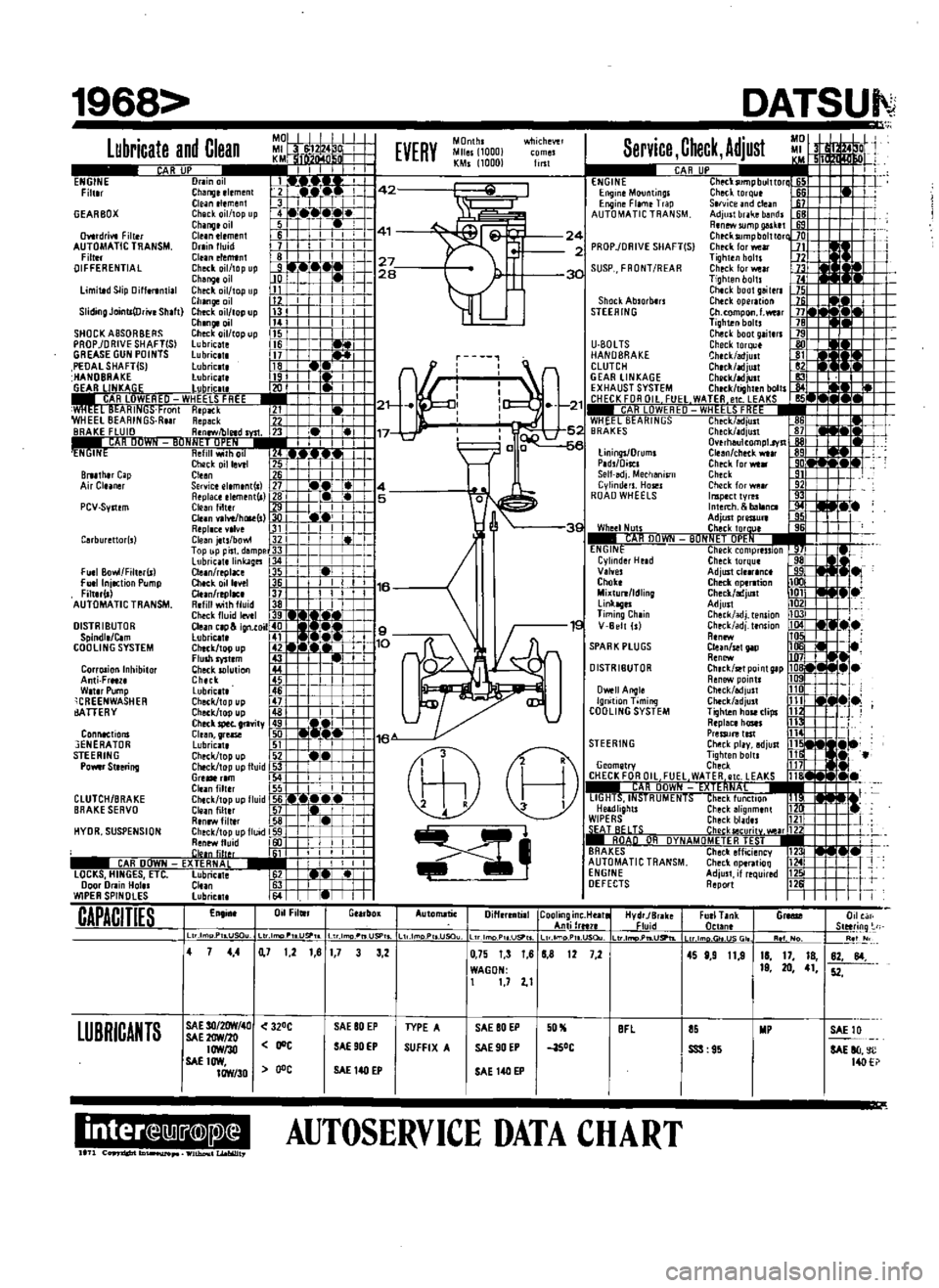
MO
MI
1224
D
I
KM
f
fMn
n
r
A
A
JP
I
I
T
I
I
I
Drain
ill
Changeelemenl
I
42
Cleantlement
3
I
II
r
I
Check
il
topup
4
I
Chinnloil
511
1
11
41
Gle
nelern
n
Ii
I
Orainlluid
7
I
I
I
I
Clunertmtn
81
1
I
I
I
I
I
27
Check
ailltop
up
Jf71
r
I
JIO
WI
28
Change
il
I
ill
limittdSlip
DiHlranti
1
Clleck
ilftopup
1J
I
I
I
Changelil
11
i
ill
ShdmgJolntt
Df
YlShlft
Check
11IIOpup
n
II
I
I
ChangeDl1
1
I
I
I
I
SHOCKASSORBERS
Check
Il
topup
5
PROP
DRIVESHAFTISI
lubncate
Hi
1
GREASE
GUN
POINTS
lubnCIl
it
PEOAlSHAFT
Sj
Lubrlc
te
18
HANDBHAKE
lubnc
1t
I
I
r
1
t
R
IINKAl
iF
luhncll
2u
I
I
i
I
ARlUWIORED
WHEELS
FREE
1m
I
I
i
1121
wHEE
L
tll
AHINli
ronl
HepitCk
211
t
f
WHEEl
BEARINGS
Rur
Repack
77
U
I
BRAKE
FLUID
R
nfWfbletd
1
I
lf
13
117
I
t
I
AH
UUWI
f
t1UN
11Itl
ih1tl
1
i
lcl
Check
oillevtl
B
l
r1i
BI1I1I1
r
Cap
Cleen
1ifj
j
I
Air
Cluner
Service
el
m
nt
l
J7
4
Replace
element
l
l
B
L
5
Cteenfilter
1
C
l
I
I
I
4
Clun
va
vellllR
I
I1
I
I
I
Repl
cH
lve
1
I
I
I
I
Cleen
jets
bOM
R
t
I
Top
liP
pisl
dempe
l
I
r
L
LlIbncatelinkages
I
I
L
Ctean
replace
5
j
I
Ch
ckoill
ve1
Ei
l
j
16
Clun
replac
n
11
R
fill
witll
fluid
38
I
Check
fluid
levll
IlL
t
I
CI
ign
toil
t
i
I
t
1
l
9
CheCk
top
u
p
10
Flulhryst
m
y
Cllecksolullon
44
Chltk
45
Lubrlc
tt
46
i
Clleck
top
up
L
L
Check
topup
4
aJdM
Cllltkspet
gl1vity
i
CI
en
gr
1S
liD
116
Lubriclt
1il
If
I
II
Clleck
topup
52
1
i
Chtck
topuplluid
3
I
I
Gre
rlm
4
I
1
I
I
I
Clunfiltlr
55
L
I
I
I
Chick
top
up
fluid
I6
w
W
e
I
ofi
Ldtir
1
Renewfiltlr
58
I
Check
topupflu
d
i91
i
I
i
Renrwfluid
I
I
I
I
I
ilinlil1r
11
I
I
I
I
I
I
CAR
DOWN
E
TERNAL
j
II
1
I
1
lOCKS
HINGES
Ell
Lubrictt
S21
r
1
el
L
Door
Dram
Hol
l
Clun
f
J
I
I
WIPER
SPINDLES
lubrictt
64
W
I
I
En
in
Dil
Filwr
GttrbOK
1968
Lubricate
and
Clean
ENGINE
Filt
r
GEARBOX
Dvttdrivt
Filt
r
AUTOMATIC
TRANSM
Filt
r
DIFFERENTIAL
PCV
Syllem
rburettor
s
FUll
Bowl
Filter
S1
Fu
llnjectionPump
Fittll
ll
AUTOMATIC
TRANSM
DISTRIBUTOR
Spindl
Ctm
COOLING
SYSTEM
CorrDlionlnllibitor
Anti
Frltl
W
t
rPump
CREENWASHER
ArrERY
Connections
3ENERATOR
STEERING
POMrStlering
CLUTCH
BRAKE
BRAKE
SERVO
HYDR
SUSPENSION
CAPACITIES
LUBRICANTS
Il
D
P
LUSClu
Service
Check
Adjust
CAR
UP
I
l
lletksumpbulttortM
1
Clled
rque
i6
ServiceJndclean
J1
Adjult
brake
bandl
tB
RtnMsumpgal
tt
fiS
Check
llJmpbnlttort
PROP
lOAIVE
SHAFT
S
Check
lor
wear
JJ
Tiglltenbolu
Jl
Check
tor
wear
n
Tiglltenboltl
Clllckbootgeiltrl
Clleckoperltion
Ch
CQmpon
l
welr
Tighten
bolts
Clleclbootgaiterl
Checktorqu
Gheck
edjult
Clllck
ljust
CIIRCk
adjult
Clleck
tighltnbolts
W
M
KSI
1
t
heCklMliiili
86
Check
ldjust
81
Overllllulcompl
rvll
Cleen
chltkwtlr
R9
Check
for
wear
0
Check
9
Checkforwp
lr
192
Il1Ipecttyrel
1IJ
Illte
II
blIl1nCl
Adjultpres
lure
Cllecktorul
liON
ET
OPE
l
heckcompression
Checktorqul
AdjUltclttr
nc
CheckoptTltion
Check
lIljLllt
AdjUlI
Clleck
alIj
tension
adj
t
nsion
I
Clun
selpp
jt1
Renew
Chetk
tPoint
tp
Renew
pointl
Check
6djult
110
J
Check
edjult
ill
i
ii
j
Tiglltenhoseclips
112
R
plece
lIastl
ill
PreSSIJ
test
114
1
STEERING
Clleek
play
adjust
ill
j
i
itl
e
Ti9htenboltl
ill
ii
Geometry
Check
U1L
H
CHECK
FOR
Oil
FUEL
WATER
etc
LEAKS
1181
I
I
R
DOWN
FXIE
HNA
11
1
1
lIGHTS
If
isfHUMt
NTS
Check
flll
C
lOn
f
3
Headlights
Checkllhgnmlnt
112Cr
WIPERS
Checkbladu
11111
J
TS
r
h
kIl
CII
I
Jrl7
iI
An
UH
OVNAUOMFTER
I
ST
I
BRAKES
CheCkemCienCY
1
I
AUTOMATIC
TRANSM
Clleek
op
rttioQ
T
ENGINE
Adjust
if
required
12
DEFECTS
Report
12
EVERY
MOnthl
Miles
1000
KMs
1000
lIBt
wtJichewl
ENGINE
EngmlMountings
Engine
Film
Trap
AUTOMATIC
TRANSM
24
2
30
SUSP
FRONT
REAR
Shock
Ablorb
rs
STEERING
1
21
5
1
c
e
U
80lTS
HANDBRAKE
CLUTCH
GEAR
LINKAGE
EXHAUST
SYSTEM
f
HFf
K
FOR
Oil
FllE
1
CAH
LUWI
RI
If
WHEEL
BEARINGS
BRAKES
UningsJDruml
Plds
Discl
Selhdj
Meclleni5l11
Cylinders
Hosel
ROAD
WHEELS
3S
Whe
1
Nun
AHllIIWN
ENGINE
Cyllnd
r
Held
Vllyes
Clloke
MiKtulli
ldling
linkagel
Timing
Ch
in
16
V
Belt
Is
SPARK
PLUGS
OISTRIBUTOR
Owell
Angle
Ignition
Timing
COOLING
SYSTEM
8
X
Automatic
Diffrrrntill
ICoolinginc
Ht
lltel
AntilrH1f
Ltr
lmoP
Ugo
IL
dmo
PII
U
Ou
HydrJBrak
Fluid
4
7
1
21
81
7
ULlma
II
USP
ULlmD
USP
L
L
tmoP
USQu
127
2
4
4
SAE
3O
2OW
411
SAE
lfrN
2fJ
IOWI3O
SAE1OW
IOW
30
320C
JOe
o
e
SAE80
EP
SAE90EP
SAE
140
EP
mmDIIIII
Ifn
c
ID
WIthDv
1
LI
obWt7
3
LtrJ
PtLUSPtL
3
2
0
75
T
3
1
8
B
8
WAGON
1
1
72
1
TYPE
A
SUFFIX
A
SAE80
EP
SAE90EP
SAE
140EP
0
aSoC
BFl
AUTOSERVICE
DATA
CHART
DATSUI
D
FurlT
nk
n
tln
G
0
Slltring
Re
I
lm
r
JSGI
11
1
No
4S
8
9
11
9
11
17
18
19
20
41
82
84
52
SSS
95
SAElll
SAE
80
c
14O